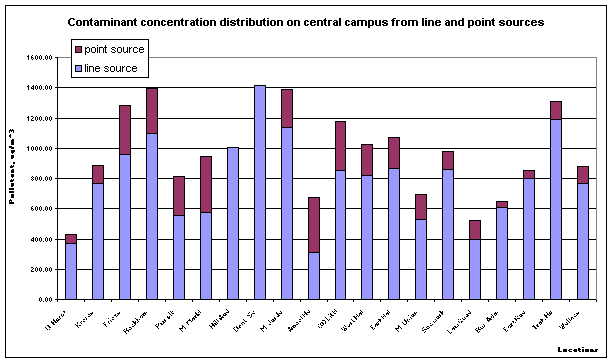|
Exercises
Intermediate
1.
a.)
Using the
Vehicle Design Module, determine the annual fuel cost for the
current Saturn SL1 model with an automatic transmission. Next, look
at the cost of the same vehicle with an ultra-lightweight chassis
that reduces the overall vehicle weight by 500 lbs. If using these
new materials added $400 to the cost of the vehicle, how long would
it take (assuming an avg driving cycle of 15,000 miles per year)
before the consumer gained a financial benefit from purchasing the
lighter vehicle?
b.)
At the
point in time when the consumer with the lighter Saturn “breaks
even” on the vehicle purchase (solution to 1a), how many gallons of
gas has he or she conserved relative to the original Saturn
configuration?
2. Go to
The National Weather Service forecast page for Ann Arbor to get
the current weather conditions. Determine surface wind speed
(m/s), wind direction (degrees, clockwise from North = 0), and
stability class (see determination criteria).
Assume a mixing height of 100 meters. Assume a fleet of
vehicles utilizing a manual transmission, CD = 0.385, and vehicle
weight of 2625 lbs. Manually calculate the concentration of carbon
monoxide at the Michigan Union due to the U of M Power Plant and
vehicles traveling down State Street. (Assume an ambient CO
concentration of 3 ppm).
Power Plant
Assumptions:
|
Location (x(m), y(m)) |
Effective Stack Height (m) |
Wind
Speed at Stack Height (m/s) |
|
(911, 1192) |
100 |
1.41 |
To determine
the emission factor of the coal-fired power plant, assume the plant
generally emits 0.5 lbs of CO per ton of coal burned. The heating value of coal is 26 million Btu/ton
of coal burned. Finally, assume the plant capacity is 1
mega-watt, and that the plant is 25% efficient.
The concentrations determined
from the Gaussian line source and point source equations for the
receptor of interest are additive.
3. a.) Assume
Ann Arbor's vehicle fleet is composed entirely of fuel cell vehicles
(with CD = 0.285 and vehicle weight = 2125 lbs).
This will require a power plant to reform H2 and could
have implications that could potentially offset the pollution
savings from these low emission vehicles. A coal-fired power
plant will be constructed in the location of the Frieze Building
(once it is torn down). Assume that the same meteorological
conditions hold that you determined in part 2. Now include the H2 reforming power plant with the following parameters:
|
Location (x(m), y(m)) |
Effective Stack Height (m) |
Wind
Speed at Stack Height (m/s) |
|
(508, 1206) |
75 |
1.41 |
To determine the
capacity of this plant, assume that hydrogen cars require
0.35
kW-h/mi. Assume there are an average of 300 vehicles on the
road at any given time. Assume that all vehicles are traveling
on average at 35 mph.
To determine
the emission factor of the coal-fired power plant, assume the plant
generally emits 0.5 lbs of CO per ton of coal burned. The heating value of coal is 26 million Btu/ton
of coal burned.
Calculate the concentration of
CO at three different receptors (of your choice) due to the
contribution from vehicles traveling down three different roads (of
your choice), due to the hydrogen reforming power plant and due to
the U of M power plant. These three terms are additive. Display your
results in an excel worksheet in a layered bar graph showing the
respective contributions (however, you will only have three columns
presented in your graph).
Example:

b.)
How do your observed pollutant concentrations compare to the
National Ambient Air Quality Standards
for CO?
4.
A manufacturer’s CAFE is the fleet wide average fuel economy. The
averaging method used is referred to as a “harmonic mean”. The
regulatory language describes the calculation as: “the number of
passenger automobiles manufactured by the manufacturer in a model
year; divided by the sum of the fractions obtained by dividing the
number of passenger automobiles of each model manufactured by the
manufacturer in that model year by the fuel economy measured for
that model.”
|
Model |
MPG |
Production Volume |
|
Vehicle A |
29 |
130,000 |
|
Vehicle B |
26 |
120,000 |
|
Vehicle C |
25 |
100,000 |
|
New Saturn |
X |
Z |
a.) Calculate
the average
fuel economy ratings for the manufacturer’s fleet of vehicles
assuming only vehicles A, B, and C are produced.
b.)
The CAFE
standards are applied on a fleet-wide basis for each manufacturer;
i.e., the fuel economy ratings for a manufacturer's entire line of
passenger cars must average at least 27.5 mpg for the manufacturer
to comply with the standard. [If a manufacturer does not meet the
standard, it is liable for a civil penalty of $5.00 for each 0.1 mpg
its fleet falls below the standard, multiplied by the number of
vehicles it produces. For example, if a manufacturer produces 2
million cars in a particular model year, and its CAFE falls 0.5 mpg
below the standard, it would be liable for a civil penalty of $50
million.] Using your answer in part (a), determine what (if any)
penalty the manufacturer faces in this scenario.
c.) The
company has decided that they will comply with CAFE standards by any
means necessary. One solution involves creating a new Saturn
vehicle that will help the company achieve the 27.5 mpg CAFE
standards. Using the Vehicle Design Module determine X and Z (in
the table above) for each powertrain option assuming that the sleek,
low drag bodystyle will be chosen with a vehicle weight of 2625 lbs.
d.) In
a paragraph or less, discuss environmental concerns associated with
the alternative powertrains.
5. Discuss
assumptions and uncertainty in the vehicle design aspects and the
pollution modeling aspects of this module. How will one error
propagate to further amplify uncertainty?
|